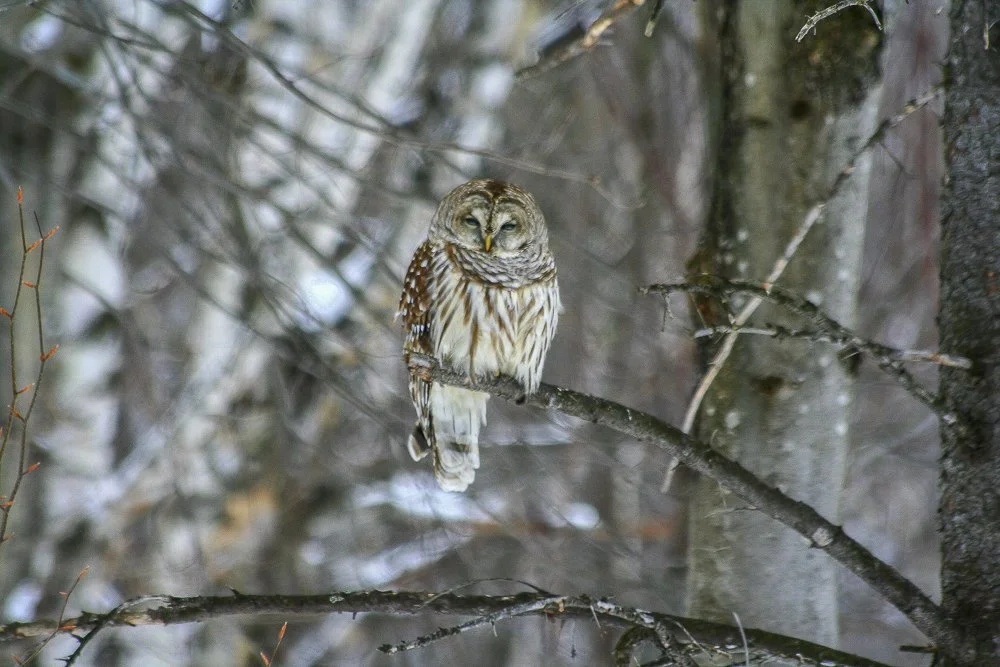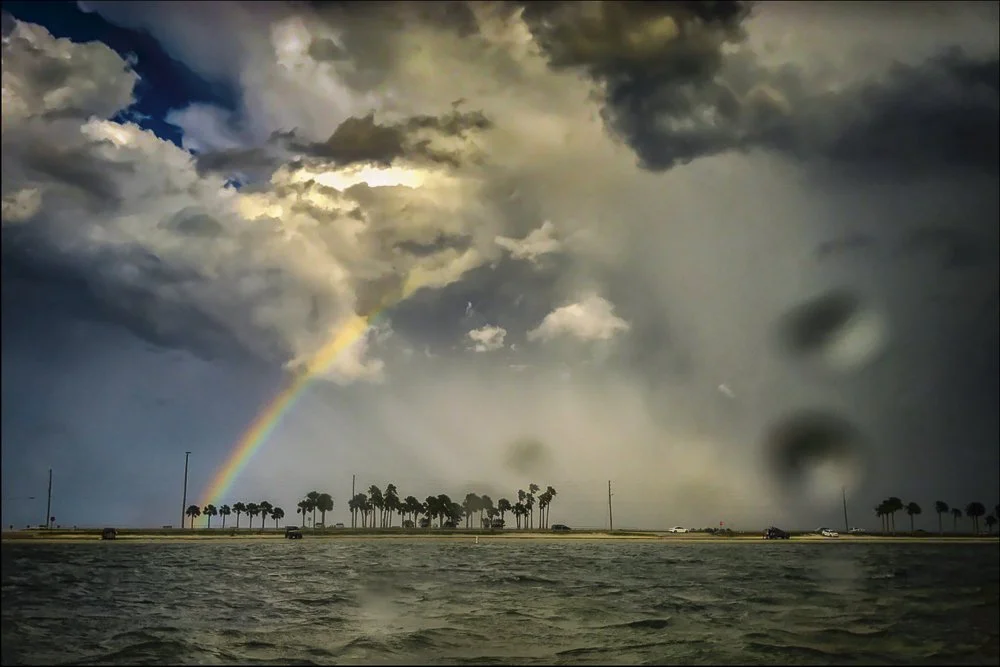Navigating the Journey from Anxiety to Empowerment
Every morning, I step outside with little Lucy to greet the day. “Good morning, Grandmother Earth! Good morning, Tree friends! Good morning, Bird friends! Good morning, Mountains! Good morning, Greta Groundhog!” I pause, inviting in my guides and protectors, and almost always, deep gratitude fills me.
My morning view. 😍 © 2025 Carla Royal.
But this morning, my gratitude came with tears of fear and concern.
Unfortunately, I read the news before I got out of bed. I know this is a terrible idea. I know I need to get myself grounded and connected to this beautiful world before going down the rabbit hole of disturbing news. I know better. But this morning, I disregarded my own rules. I got spooked.
I believe I have reason to be afraid. Fear is not a bad emotion. Fear has saved our lives countless times. It’s why we jump back from a speeding car. It’s why we pull our hands back from the fire. It’s why I slow down when I realize I’m taking a curve too fast (though I do love going fast!). It’s why I’m always respectful when I’m on top of a horse. Fear is wired into us for a reason, and I am grateful for it.
But I also know that fear can become a trap.
Fear can guide or imprison us, depending on how we respond to it. And when the fear comes, especially the kind stirred by what’s happening in the world, it can be easy to spiral. Joanna Macy, who studies deep ecology and Buddhist philosophy, talks about active hope—the idea that we can practice hope instead of waiting for it to arrive. She reminds us that fear and grief are not signs of weakness but proof of our deep love for the world. If we feel afraid, it means we care.
But all fear is not created equal. There’s also fear that isn’t rational. Often, we feel fear when there is no danger at all.
Frozen in Fear: A Moment of Public Paralysis
When I was twelve, a friend and I were asked to sing a duet in church. Before the song, we were each supposed to share a little about our lives. My friend went first and spoke beautifully. Then it was my turn. I froze! Nothing came out of my mouth. My mind went completely blank. I was terrified. Everybody was staring at me, waiting. Finally, the piano player started playing, and my friend began singing. I somehow stumbled through the song. But the humiliation and that feeling of fear stayed with me for decades.
It was 50 years before I stood on a stage to speak again. I was invited to give a keynote talk for a company I worked with. I didn’t tell them I had never given a talk, I just said yes immediately despite being terrified. I knew I was ready to face this fear. I prepared well. I practiced. And when I stepped on that stage, I spoke with clarity and confidence. I even got a standing ovation. No one could’ve guessed I had never given a talk before. The most surprising thing was that my fear melted away the moment I took the stage. It was such an empowering experience. I still fear speaking, but the fear no longer paralyzes me.
We are at a time now when we can’t afford to collapse into fear. We must step up even when afraid. Our future depends on it.
The Hero’s Journey: Embracing Fear as a Catalyst for Growth
The hero’s journey doesn’t start with fear. It starts with a sense that something is shifting, something is being asked of us. Then fear rushes in. That’s when the hero’s journey begins. There is hesitation, doubt, and the overwhelming urge to turn back. Joseph Campbell, who studied world mythologies, called this the call to adventure. That’s the moment when the hero must decide whether they will answer the call or retreat back to safety.
The myths tell us that fear is not a sign that we’re on the wrong path. It’s often a sign that we’re standing at the edge of something important. That precipice between groundlessness and flight, as Ani DiFranco puts it.
The hero doesn’t become the hero by avoiding fear (spiritual bypassing, toxic positivity, suppression, acting out in anger) or by being consumed by it (shutting down, collapsing on the couch, hiding from life). They become heroes by facing and moving through it. And they don’t do it alone. In every great myth, the hero has a guide, a mentor, or a community. Luke Skywalker has Obi-Wan. Frodo has Gandalf. I have my friends and coach. Who are you choosing to walk with in these uncertain times? Fear is easier to move through when we have people beside us.
Ancient Wisdom: Viewing Fear as a Sacred Messenger
The ancient traditions understood that fear isn’t something to fight, but something to listen to.
Many Indigenous teachings say that fear isn’t an enemy but a spirit that comes to test our readiness. The Lakota believe fear is an invitation to deepen our wisdom. If we push it away too quickly, we miss what it has to teach us. If we collapse into it, we become stuck. The goal is to acknowledge fear, listen for its wisdom, and then move accordingly.
The samurai understood fear as something to be met with presence, not something to be conquered. Zen master Takuan Soho taught warriors that fear should not be resisted or suppressed but instead observed with a steady mind. A young samurai once asked his master how to deal with fear in battle. The master replied, “You do not fight fear; you let it pass through you, like wind through the trees. Acknowledge it, listen to it, and then act.” This teaching, rooted in Zen and Bushido, reinforced that fear itself isn’t the enemy, our reaction to it can be.
Practical Strategies: Transforming Fear into Empowerment
Often, we want to wait until we don’t feel the fear, the path is clearer, or the stakes aren’t so high. But that can be a trick the mind plays on us. The only way to deal with fear is by going straight through it.
Here are a few grounded, research-backed practices I’ve found helpful in working with fear:
Acknowledge it – Name the fear. The moment you do, it loses some of its grip. Talk to yourself like you’d talk to a friend. Instead of “I’m so scared,” say: “I know you’re feeling scared, and that’s okay.” Or “[Your Name—I use a beloved nickname], you’ve been through hell before and found your way. We’ve got this.” That little shift creates just enough space between you and the emotion to loosen some of its grip.
Regulate your breath – Fear tightens your body, breathing, and thinking. Slow, steady breaths tell your nervous system you’re safe. I’ve found that if I take a deep breath, hold it as long as possible, and do that a few times, my system starts to calm down. And if I hum while exhaling that breath, it’s even better. It’s like hitting reset.
Get curious – Ask fear what it wants instead of fighting it. What is this really about? What is it trying to protect me from, Am I really in danger right this moment? Fear has a way of pointing to what matters. If you listen, it might show you something useful.
Take a step, any step –The longer you sit in fear, the bigger it gets. That’s what my bungee jumping guide told me: “It’s not going to get any easier.” Move in some way. Even if it’s small. Send the message. Take a walk. Say the thing. Fear shrinks when you stop letting it freeze you.
Remember, it’s temporary – Fear is like clouds in the sky. They come and go. It is not forever. When you stop treating it like something solid, it begins to lose its power—not immediately but over time. Maya Angelou, the world-renowned poet and scholar, said,
What I know is that it's going to be better. If it's bad, it might get worse, but I know that it's going to be better. And you have to know that. There's a country song out now, which I wish I'd written, that says, 'Every storm runs out of rain.' I'd make a sign of that if I were you. Put that on your writing pad. No matter how dull and seemingly unpromising life is right now, it's going to change. It's going to be better. But you have to keep working.
Recognizing When Fear Signals the Need to Pull Back
It’s important that we not ignore our fear. Sometimes, it’s asking us to pause, listen, and discern before acting. There is wisdom in knowing the difference between fear that’s truly keeping us safe and when it’s keeping us small, frozen, or over-reacting.
There are times when fear is a clear signal to stop and walk away from a harmful situation, to recognize when you’re depleted, to see that you’re about to push past your limits in a way that won’t serve you. Sometimes, what feels like resistance is actually intuition telling you not yet or even not this way. Fear is a warning and only an obstacle when we overreact to it or don’t heed it when we aren’t safe. The key is to listen deeply enough to know what the fear points to at this particular moment.
James Baldwin wrote,
Not everything that is faced can be changed, but nothing can be changed until it is faced.
It’s a powerful reminder that facing fear, whatever form it takes, is where transformation begins.
Yes, the world is uncertain. And yes, there are things to fear. But fear isn’t the enemy. In many ways, it’s a map pointing us to what matters, calling us to step forward, reminding us to care for ourselves in the process.
So, move when it’s time to move. Rest when it’s time to rest. Trust that you’ll know the difference. Because every storm runs out of rain.















